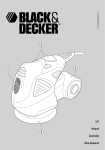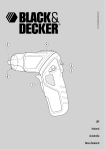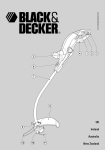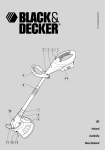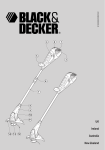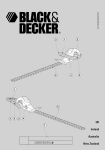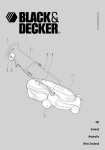Download Black & Decker Circular Saws Instruction manual
Transcript
www.blackanddecker.com 2 1 6 3 5 17 4 8 7 10 13 11 9 12 2 1 3 17 6 5 4 16 10 9 8 7 UK 14 Ireland 11 15 12 Australia New Zealand 1 23 20 19 22 18 21 2-3 mm A B 2-3 mm 13 6 24 12 C 2 5 25 D 11 28 27 8 26 7 11 E F 33 14 30 31 29 32 15 G 3 Intended use Your Black & Decker saw has been designed for sawing wood and wood products. This tool is intended for consumer use only. General safety rules Warning! Read all instructions. Failure to follow all instructions listed below may result in electric shock, fire and/or serious injury. The term “power tool” in all of the warnings listed below refers to your mains operated (corded) power tool or battery operated (cordless) power tool. SAVE THESE INSTRUCTIONS. 1. Work area a. Keep work area clean and well lit. Cluttered and dark areas invite accidents. b. Do not operate power tools in explosive atmospheres, such as in the presence of flammable liquids, gases or dust. Power tools create sparks which may ignite the dust or fumes. c. Keep children and bystanders away while operating a power tool. Distractions can cause you to lose control. 2. Electrical safety a. Power tool plugs must match the outlet. Never modify the plug in any way. Do not use any adapter plugs with earthed (grounded) power tools. Unmodified plugs and matching outlets will reduce risk of electric shock. b. Avoid body contact with earthed or grounded surfaces such as pipes, radiators, ranges and refrigerators. There is an increased risk of electric shock if your body is earthed or grounded. c. Do not expose power tools to rain or wet conditions. Water entering a power tool will increase the risk of electric shock. d. Do not abuse the cord. Never use the cord for carrying, pulling or unplugging the power tool. Keep cord away from heat, oil, sharp edges or moving parts. Damaged or entangled cords increase the risk of electric shock. e. When operating a power tool outdoors, use an extension cord suitable for outdoor use. Use of a cord suitable for outdoor use reduces the risk of electric shock. 3. Personal safety a. Stay alert, watch what you are doing and use common sense when operating a power tool. Do not use a power tool while you are tired or under the influence of drugs, alcohol or medication. A moment of inattention while operating power tools may result in serious personal injury. 4 b. Use safety equipment. Always wear eye protection. Safety equipment such as dust mask, non-skid safety shoes, hard hat, or hearing protection used for appropriate conditions will reduce personal injuries. c. Avoid accidental starting. Ensure the switch is in the off position before plugging in. Carrying power tools with your finger on the switch or plugging in power tools that have the switch on invites accidents. d. Remove any adjusting key or wrench before turning the power tool on. A wrench or a key left attached to a rotating part of the power tool may result in personal injury. e. Do not overreach. Keep proper footing and balance at all times. This enables better control of the power tool in unexpected situations. f. Dress properly. Do not wear loose clothing or jewellery. Keep your hair, clothing and gloves away from moving parts. Loose clothes, jewellery or long hair can be caught in moving parts. g. If devices are provided for the connection of dust extraction and collection facilities, ensure these are connected and properly used. Use of these devices can reduce dust related hazards. 4. Power tool use and care a. Do not force the power tool. Use the correct power tool for your application. The correct power tool will do the job better and safer at the rate for which it was designed. b. Do not use the power tool if the switch does not turn it on and off. Any power tool that cannot be controlled with the switch is dangerous and must be repaired. c. Disconnect the plug from the power source before making any adjustments, changing accessories, or storing power tools. Such preventive safety measures reduce the risk of starting the power tool accidentally. d. Store idle power tools out of the reach of children and do not allow persons unfamiliar with the power tool or these instructions to operate the power tool. Power tools are dangerous in the hands of untrained users. e. Maintain power tools. Check for misalignment or binding of moving parts, breakage of parts and any other condition that may affect the power tools operation. If damaged, have the power tool repaired before use. Many accidents are caused by poorly maintained power tools. f. Keep cutting tools sharp and clean. Properly maintained cutting tools with sharp cutting edges are less likely to bind and are easier to control. g. Use the power tool, accessories and tool bits etc., in accordance with these instructions and in the manner intended for the particular type of power tool, taking into account the working conditions and the work to be performed. Use of the power tool for operations different from those intended could result in a hazardous situation. 5. Service a. Have your power tool serviced by a qualified repair person using only identical replacement parts. This will ensure that the safety of the power tool is maintained. – when the blade is pinched or bound tightly by the kerf closing down, the blade stalls and the motor reaction drives the unit rapidly back toward the operator; – if the blade becomes twisted or misaligned in the cut, the teeth at the back edge of the blade can dig into the top surface of the wood causing the blade to climb out of the kerf and jump back toward the operator. Kickback is the result of saw misuse and/or incorrect operating procedures or conditions and can be avoided by taking proper precautions as given below. ◆ Safety instructions for all saws Danger: ◆ ◆ ◆ ◆ ◆ ◆ ◆ ◆ Keep hands away from cutting area and the blade. Keep your second hand on auxiliary handle, or motor housing. If both hands are holding the saw, they cannot be cut by the blade. Do not reach underneath the workpiece. The guard cannot protect you from the blade below the workpiece. Adjust the cutting depth to the thickness of the workpiece. Less than a full tooth of the blade teeth should be visible below the workpiece. Never hold piece being cut in your hands or across your leg. Secure the workpiece to a stable platform. It is important to support the work properly to minimize body exposure, blade binding, or loss of control. Hold power tool by insulated gripping surfaces when performing an operation where the cutting tool may contact hidden wiring or its own cord. Contact with a “live” wire will also make exposed metal parts of the power tool “live” and shock the operator. When ripping always use a rip fence or straight edge guide. This improves the accuracy of cut and reduces the chance of blade binding. Always use blades with correct size and shape (diamond versus round) of arbour holes. Blades that do not match the mounting hardware of the saw will run eccentrically, causing loss of control. Never use damaged or incorrect blade washers or bolt. The blade washers and bolt were specially designed for your saw, for optimum performance and safety of operation. ◆ ◆ ◆ ◆ ◆ ◆ Maintain a firm grip with both hands on the saw and position your arms to resist kickback forces. Position your body to either side of the blade, but not in line with the blade. Kickback could cause the saw to jump backwards, but kickback forces can be controlled by the operator, if proper precautions are taken. When blade is binding, or when interrupting a cut for any reason, release the trigger and hold the saw motionless in the material until the blade comes to a complete stop. Never attempt to remove the saw from the work or pull the saw backward while the blade is in motion or kickback may occur. Investigate and take corrective actions to eliminate the cause of blade binding. When restarting a saw in the workpiece, centre the saw blade in the kerf and check that saw teeth are not engaged into the material. If saw blade is binding, it may walk up or kickback from the workpiece as the saw is restarted. Support large panels to minimise the risk of blade pinching and kickback. Large panels tend to sag under their own weight. Supports must be placed under the panel on both sides, near the line of cut and near the edge of the panel. Do not use dull or damaged blades. Unsharpened or improperly set blades produce narrow kerf causing excessive friction, blade binding and kickback. Blade depth and bevel adjusting locking levers must be tight and secure before making cut. If blade adjustment shifts while cutting, it may cause binding and kickback. Use extra caution when making a “plunge cut” into existing walls or other blind areas. The protruding blade may cut objects that can cause kickback. Further safety instructions for all saws Causes and operator prevention of kickback: – kickback is a sudden reaction to a pinched, bound or misaligned saw blade, causing an uncontrolled saw to lift up and out of the workpiece toward the operator; 5 Safety instructions for saws with a pendulum blade guard ◆ Check lower guard for proper closing before each use. Do not operate the saw if lower guard does not move freely and close instantly. Never clamp or tie the lower guard into the open position. If saw is accidentally dropped, lower guard may be bent. Raise the lower guard with the retracting handle and make sure it moves freely and does not touch the blade or any other part, in all angles and depths of cut. ◆ Check the operation of the lower guard spring. If the guard and the spring are not operating properly, they must be serviced before use. Lower guard may operate sluggishly due to damaged parts, gummy deposits, or a build-up of debris. ◆ Lower guard should be retracted manually only for special cuts such as “plunge cuts” and “compound cuts.” Raise lower guard by retracting handle and as soon as blade enters the material, the lower guard must be released. For all other sawing, the lower guard should operate automatically. ◆ Always observe that the lower guard is covering the blade before placing saw down on bench or floor. An unprotected, coasting blade will cause the saw to walk backwards, cutting whatever is in its path. Be aware of the time it takes for the blade to stop after switch is released. Additional safety instructions for all saws with riving knife ◆ Use the appropriate riving knife for the blade being used. For the riving knife to work, it must be thicker than the body of the blade but thinner than the tooth set of the blade. ◆ Adjust the riving knife as described in this instruction manual. Incorrect spacing, positioning and alignment can make the riving knife ineffective in preventing kickback. ◆ Always use the riving knife except when plunge cutting. Riving knife must be replaced after plunge cutting. Riving knife causes interference during plunge cutting and can create kickback. ◆ For the riving knife to work, it must be engaged in the workpiece. The riving knife is ineffective in preventing kickback during short cuts. ◆ Do not operate the saw if riving knife is bent. Even a light interference can slow the closing rate of a guard. Additional safety instructions for circular saws ◆ Wear ear protectors. Exposure to noise can cause hearing loss. ◆ Preferably wear a dust mask. 6 ◆ ◆ Do not use blades of larger or smaller diameter than recommended. For the proper blade rating refer to the technical data. Use only the blades specified in this manual, complying with EN 847-1. Never use abrasive cut-off wheels. Electrical safety This tool is double insulated; therefore no earth wire is required. Always check that the power supply corresponds to the voltage on the rating plate. ◆ ◆ This appliance is not intended for use by young or infirm persons without supervision. Children must be supervised to ensure they do not play with the appliance. If the supply cord is damaged, it must be replaced by the manufacturer or an authorised Black & Decker Service Centre in order to avoid a hazard. Overview 1. 2. 3. 4. 5. 6. 7. 8. 9. 10. 11. 12. 13. 14. 15. 16. 17. On/off switch Lock-off button Main handle Secondary handle Locking knob for depth of cut adjustment Depth of cut scale Locking knob for mitre angle adjustment Mitre angle scale Saw blade guard Retracting lever for saw blade guard Saw shoe Parallel fence Riving knife Window (KS65K) Sight guide (KS65K) Spindle lock (KS65K) Saw dust outlet Assembly Warning! Before attempting any of the following operations, make sure that the tool is switched off and unplugged and that the saw blade has stopped. Removing and fitting a saw blade (fig. A) Removing ◆ Insert a screwdriver into the hole (18) to prevent the saw blade from rotating. KS65K: keep the spindle lock (16) depressed. ◆ Loosen and remove the blade retaining screw (20) by turning it counterclockwise using the spanner supplied. ◆ ◆ Remove the outer washer (19). Remove the saw blade (21). Fitting ◆ Place the saw blade onto the inner washer (22), making sure that the arrow on the blade points in the same direction as the arrow on the tool. ◆ Fit the outer washer (19) on the spindle, with the raised part pointing away from the saw blade. ◆ Insert the blade retaining screw (20) into the hole. ◆ Insert a screwdriver into the hole (18) to prevent the saw blade from rotating. KS65K: keep the spindle lock (16) depressed. ◆ Securely tighten the blade retaining screw by turning it clockwise using the spanner supplied. ◆ Adjust the riving knife as described below. Adjusting the riving knife (fig. B) The riving knife prevents the saw blade from jamming during rip sawing operations. The riving knife must be adjusted after replacing the saw blade. ◆ KS64(K)/KS65K: set the saw shoe to the minimum depth of cut as described below. KS55: the screws (23) can be accessed through the holes in the guard. ◆ Loosen the two screws (23). ◆ Position the riving knife (13) as shown. – The distance between the toothed rim and the riving knife should be 2 - 3 mm. – The height difference between the toothed rim and the lower end of the riving knife should be 2 - 3 mm. ◆ Tighten the screws (23). Fitting and removing the parallel fence (fig. C) The parallel fence is used to saw in a straight line parallel to the edge of the workpiece. Fitting ◆ Loosen the locking knob (24). ◆ Insert the parallel fence (12) through the openings (25). ◆ Slide the parallel fence into the desired position. ◆ Tighten the locking knob. Removing ◆ Loosen the locking knob (24). ◆ Pull the parallel fence off the tool. Use Warning! Let the tool work at its own pace. Do not overload. This tool can be used in the right hand or the left hand. Warning! Carefully guide the cable in order to avoid accidentally cutting it. Adjusting the depth of cut (fig. D) The depth of cut should be set according to the thickness of the workpiece. It should exceed the thickness by approx. 2 mm. ◆ Loosen the knob (5) to unlock the saw shoe. ◆ Move the saw shoe (11) into the desired position. The corresponding depth of cut can be read from the scale (6). ◆ Tighten the knob to lock the saw shoe in place. Adjusting the mitre angle (fig. E) This tool can be set to mitre angles between 0° and 45°. ◆ Loosen the locking knob (7) to unlock the saw shoe. ◆ Move the saw shoe (11) into the desired position. The corresponding mitre angle can be read from the scale (8). ◆ Tighten the locking knob to lock the saw shoe in place. Switching on and off Warning! Before switching on, make sure that the spanner has been removed from the blade retaining screw and that the screwdriver has been removed from the tool. Switching on ◆ Keep the lock-off button (2) depressed and press the on/off switch (1). ◆ Release the lock-off button. Switching off ◆ Release the on/off switch. KS55/KS64(K) - Aligning the saw with the cutting line (fig. F) The saw is equipped with guides for straight cutting (26) and guides for 45° mitre cutting (27). ◆ Align the left edge of the guides (26) or (27) with the cutting line (28). For very accurate cuts: ◆ Mark a cutting line on a scrap piece of wood. ◆ Align the left edge of the guides (26) or (27) with the cutting line (28). ◆ Make a test cut. ◆ Depending on the results, adjust the position of the guides relative to the cutting line. KS65K - Adjusting the sight guide (fig. G) ◆ While viewing through the window (14), align the saw blade teeth with the cutting line. ◆ While keeping the saw in this position, loosen the sight guide (15) on the saw shoe (11) as shown. ◆ Align the 0° mark (29) on the sight guide with the cutting line (31). When adjusting for 45° mitre cuts, align the 45° mark (30) on the sight guide with the cutting line. ◆ Secure the sight guide using the screw (32). 7 KS65K - Using the sight guide (fig. G) ◆ Adjust the sight guide (15) as described above. ◆ Before operating the saw, look through the window (14) to align the saw with the cutting line. Keep the sight guide (15) aligned with the cutting line while sawing. Dust extraction An adaptor is required to connect a vacuum cleaner or dust extractor to the tool. The adaptor can be purchased from your local Black & Decker retailer. ◆ Insert the dust extraction adaptor into the saw dust outlet (17). ◆ Connect the vacuum cleaner hose to the adaptor. Hints for optimum use ◆ As some splintering along the line of cut on the top side of the workpiece cannot be avoided, cut on the side where splintering is acceptable. ◆ Where splintering is to be minimised, e.g. when cutting laminates, clamp a piece of plywood onto the top of the workpiece. Accessories The performance of your tool depends on the accessory used. Black & Decker and Piranha accessories are engineered to high quality standards and designed to enhance the performance of your tool. By using these accessories you will get the very best from your tool. Maintenance Your tool has been designed to operate over a long period of time with a minimum of maintenance. Continuous satisfactory operation depends upon proper tool care and regular cleaning. ◆ Regularly clean the ventilation slots with a clean, dry paint brush. ◆ To clean the tool, use only mild soap and a damp cloth. Never let any liquid get inside the tool and never immerse any part of the tool into liquid. Mains plug replacement (U.K. & Ireland only) If a new mains plug needs to be fitted: ◆ Safely dispose of the old plug. ◆ Connect the brown lead to the live terminal in the new plug. ◆ Connect the blue lead to the neutral terminal. Warning! No connection is to be made to the earth terminal. Follow the fitting instructions supplied with good quality plugs. Recommended fuse: 13 A. 8 Protecting the environment Separate collection. This product must not be disposed of with normal household waste. Should you find one day that your Black & Decker product needs replacement, or if it is of no further use to you, do not dispose of it with household waste. Make this product available for separate collection. Separate collection of used products and packaging allows materials to be recycled and used again. Re-use of recycled materials helps prevent environmental pollution and reduces the demand for raw materials. Local regulations may provide for separate collection of electrical products from the household, at municipal waste sites or by the retailer when you purchase a new product. Black & Decker provides a facility for the collection and recycling of Black & Decker products once they have reached the end of their working life. To take advantage of this service please return your product to any authorised repair agent who will collect them on our behalf. You can check the location of your nearest authorised repair agent by contacting your local Black & Decker office at the address indicated in this manual. Alternatively, a list of authorised Black & Decker repair agents and full details of our after-sales service and contacts are available on the Internet at: www.2helpU.com Technical data Input voltage (Australia & New Zealand) Power input No-load speed Max. depth of cut Blade diameter Blade bore Blade tip width LpA (sound pressure) KpA (sound pressure uncertainty) LWA (acoustic power) KWA (acoustic power uncertainty) Hand/arm weighted vibration Weight VAC VAC W min-1 mm mm mm mm dB(A) dB(A) dB(A) dB(A) m/s2 kg KS55 230 240 1,200 5,000 55 170 16 2.6 93.2 3 104.2 3 1.74 5.4 KS64 230 KS65 230 1,300 5,000 65 190 16 2.6 95.0 3 106.0 3 2.20 5.4 1,400 5,000 65 190 16 2.6 95.0 3 106.0 3 2.20 5.4 EC declaration of conformity KS55/KS64/KS65 Black & Decker declares that these products conform to: 98/37/EC, 89/336/EEC, EN 60745, EN 55014, EN 61000 Kevin Hewitt Director of Consumer Engineering Spennymoor, County Durham DL16 6JG, United Kingdom 1-5-2006 Guarantee Black & Decker is confident of the quality of its products and offers an outstanding guarantee. This guarantee statement is in addition to and in no way prejudices your statutory rights. The guarantee is valid within the territories of the Member States of the European Union and the European Free Trade Area. If a Black & Decker product becomes defective due to faulty materials, workmanship or lack of conformity, within 24 months from the date of purchase, Black & Decker guarantees to replace defective parts, repair products subjected to fair wear and tear or replace such products to ensure minimum inconvenience to the customer unless: ◆ The product has been used for trade, professional or hire purposes; ◆ The product has been subjected to misuse or neglect; ◆ The product has sustained damage through foreign objects, substances or accidents; ◆ Repairs have been attempted by persons other than authorised repair agents or Black & Decker service staff. To claim on the guarantee, you will need to submit proof of purchase to the seller or an authorised repair agent. You can check the location of your nearest authorised repair agent by contacting your local Black & Decker office at the address indicated in this manual. Alternatively, a list of authorised Black & Decker repair agents and full details of our after-sales service and contacts are available on the Internet at: www.2helpU.com. Please register at our website www.blackanddecker.com to be kept up to date on new products and special offers. Further information on the Black & Decker brand and our range of products is available at www.blackanddecker.com. 9 TYP 1 KS55 KS64 19 3 55 20 35 4 KS55 24 55 36 56 18 14 17 KS64 57 13 5 53 15 3 23 22 40 16 1 6 3 2 7 29 51 21 10 39 38 52 41 37 28 42 2.5 2. 0 27 25 32 9 49 31 43 30 33 50 54 46 30 34 816 817 KS64 E13203 10 821 WWW.2helpU.com KS55 16 - 07 - 01 TYP 1 KS65K 3 19 20 67 70 24 69 78 14 77 68 18 66 13 17 65 63 72 64 55 15 73 74 3 23 22 4 55 36 56 57 53 40 16 5 1 6 2 3 7 29 51 21 10 39 38 52 41 37 28 42 27 31 25 43 58 46 32 9 61 62 59 76 75 49 60 50 71 816 30 33 821 34 E13216 WWW.2helpU.com 817 2.5 2. 0 54 23 - 07 - 01 11 Australia Black & Decker (Australia) Pty. Ltd. Tel. 03-8720 5100 20 Fletcher Road, Mooroolbark, Fax 03-9727 5940 Victoria, 3138 New Zealand Black & Decker 81 Hugo Johnston Drive Penrose, Auckland, New Zealand United Kingdom Black & Decker 210 Bath Road Slough, Berkshire SL1 3YD 573644-03 12 Tel. 09 579 7600 Fax 09 579 8200 Tel. 01753 511234 Fax 01753 551155 Helpline 01753 574277 05/06














